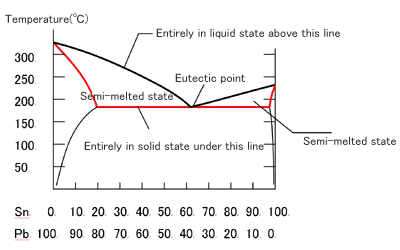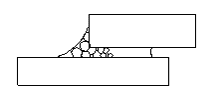

Top of Products > Solder-Aid > HIKARU'S DIARY ON LEARNING TO SOLDER > EPISODE 8: "Meeting with Mr. Suzuki again"



Hikaru joined a manufacturer.
Today is the first day of the new employee training in the company.
I'm a working member of society starting today. I feel nervous.
I'm the only new employee here? I wish there were some girls joining the company with me…
Good morning. Oh, you must be the boy on the other day.
Oh, you are Mr. Suzuki, aren't you?
I see, you joined our company. Well, it happens. Anyway, it's nice to meet you,again.
Well, then, I have not asked your name. Please introduce yourself.
I'm Hikaru Jyo, twenty-two years old. My hobby is listening to music. I'm interested in electronic handicrafts. I'm pleased to meet you.
"Electronic handicrafts", eh. Maybe we have a lot in common. Ha-ha-ha-ha-ha (Laughing)
I'm Suzuki from the Manufacturing Section.
By the way, what were we talking about the other day? I'm getting so forgetful these days.
We were talking about the history of soldering. When I asked why the soldering technology has been used until now with little change, you had to go somewhere.
Oh, now I remember that. You have a good memory, Hiroshi.
Excuse me. My name is Hikaru ·····.
Oh, I'm sorry. I can hardly remember any names these days.
From a soldering technology point of view, the technology has been advancing rapidly. For the advance in soldering irons, soldering irons were heated with coal in the past and then modified to use electric heaters. Some of them can be temperature-controlled in order to maintain the soldering tip temperature accurately. For soldering methods, the soldering method using soldering irons has been considerably reduced in number these days. I'll talk about this later. There are a variety of soldering methods, including ultrasonic and laser soldering, as well as reflow and flow soldering. In other words, the soldering tools and soldering methods have been advanced beyond our imagination from those in the past. But, there are little changes in the materials.
I think that's true.
The answer is simple. That's because there are no other materials other than tin-lead solder. Actually, it is not necessary to change the materials. The tin-lead solder provides a relatively low melting temperature and the cost is low. It can thoroughly flow into even a narrow gap. It can spread well and wet well. The strength is also perfect. At present, from an environmental point of view, we've begun to use lead-free solder, which is solder containing no lead. But, tin-lead solder is a lot more convenient than lead-free solder.
Sounds like tin-lead solder is nearly perfect.
That's right, Wataru.
No. I'm Hikaru···.
Sorry. Age makes me so forgetful. Anyway, tin-lead solder is commonly used now. In particular, eutectic solder, or an alloy containing tin of 63% and lead of 37%, will melt instantly at a relatively low temperature of 183℃ and solidify instantly. Because of these characteristics, we prefer using eutectic solder.
What is the advantage of instant solidification?
You have many questions, indeed. You need to study on your own!
Well, having said that, I must teach you while you are in the training period.
Thank you very much.
Pure substance, or a substance without any other substance mixed in, has three states: solid, liquid and gas. However, when two or more substances are mixed, the states of solid and liquid simultaneously exist because the temperature at which the mixture starts melting is different from the temperature at which it completely melts.
Soldering must fill solder into a gap between target metals. But, if the melting start temperature is different from the melting completion temperature, the solder may not have completely melted, although it looks melted. It's a semi-melted state. Do you understand what I've explained until now?

Yes, I think I understand it.
Then, the liquid part of solder that has melted flows into the inner part of the gap but the part of solder that has not melted is left. This phenomenon is called "separated melting". This phenomenon causes the joint strength and corrosion resistance to deteriorate.
I see. I think I am getting the picture.

The same phenomenon occurs when the solder solidifies from the liquid state. Even if it looks solidified, it may not have completely solidified yet. If the target metal is moved in such a condition, a soldering failure occurs. "Eutectic" means a composition with the lowest melting point and with no difference between the melting temperature and the solidus temperature. Therefore, as with pure substance, eutectic solder will instantly melt and solidify at a constant temperature. Do you understand this?
I understand well.
OK, you learn quickly. In passing, I'll briefly explain about lead-free solder now.
Well, Hisashi!
I'm Hikaru.
Don't worry about the details. Do you know why lead-free soldering is required?
That's because lead is harmful to the body.
That's right. Lead has toxicity that affects the central nervous system in the human body. But, lead was contained in face powder and pigment in the past. Now, lead is not used for that because its toxicity was proven. Lead caused Kabuki actors to suffer from a kind of occupational disease at that time.
By the way, do you know that lead was also used in tap water piping in the past?
What?! That is terribly dangerous, isn't it?
No, it is not always dangerous. When lead is combined with carbonic acid and oxygen dissolved in water, a film of lead compound (2PbCO3・Pb(OH)2) is deposited on the inner surface of the lead pipe. Because this compound is not soluble in water, it prevents lead from dissolving into the water. Tap water was clean in the past.
Is lead used in tap water piping even now?
It is not used now. Because the water quality has deteriorated, a large quantity of disinfectant is contained in tap water and the lead compound film is difficult to deposit on the inner surface of the lead pipe.
I see.
So, why is lead-free solder necessary?
Let me see. It may be related to an environmental problem. Also, it is related to water, specifically drinking water, because solder is not supposed to be ingested.
You really understood. Yes, in this case, the problem is acid rain.
Acid rain?
Destroyed and wasted electric products are thrown away and buried under the ground as a matter of course. When they are exposed to acid rain, lead contained in solder melts away and it is mixed with underground water.
Then, underground water is taken into the body as drinking water, isn't it?
That's right. Currently, various types of lead-free solder are used. But, individual types of solder have both advantages and disadvantages.
It has not been used as commonly as tin-lead solder. Some of them have been put into practical use, but lead-free solder still has too many problems to be used commonly.
I see? But, since this problem is related to the human body, it must be solved anyway.
Only lead is regarded as a bad element, but the problem is also related to acid rain and the waste P.W.B. disposal method, I think.
That's right. At present, governmental controls such as the Electric Household Appliance Recycling Law are in effect and individual manufacturers are studying waste P.W.B. disposal methods.
We all must pay more attention to the environental problems.
Yes. You got it, Takeru!
You are calling me different names on purpose, aren't you?
Ha-ha-ha-ha-ha (Laughing)
